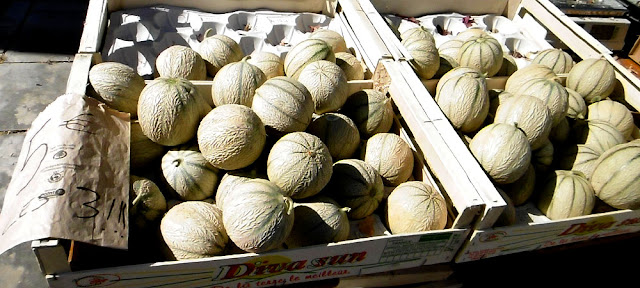If you live in the Touraine Loire Valley you eat Charentais Melon. They are
locally grown and everyone agrees -- they are the best melons in the world! No
question! Everyone who tries them agrees. We introduce them to our Australian
friends who think they are just rockmelon or cantaloupe -- until they try
them.
If you are here in July, August and September, then you must eat Charentais Melon. But they are not
served as dessert. That would be weird, and very bad for your digestion,
apparently -- according to our French friends. No, no, Charentais Melon is
served as a starter -- often on its own, unadorned; sometimes with vin d'épine noire (a
local port like drink); occasionally with air dried ham. You are also advised
not to eat them out of season -- it simply isn't worth the disappointment.
Melons marked by the producer in the order we should eat them.
Charentais Melons are small and they don't ship well, so if you want to enjoy
their intense meloniness, you will have to come to us in the summer. Accept no
substitutes. They smell like essence of melon and have a beautiful salmon
coloured flesh. You can eat them straight, as the French do, or make ice cream
or sorbet. Otherwise, don't mess with them. Just eat half a melon a day until
the season ends.
The modern variety, with its yellow netted skin and green ribs, was developed
in the Poitou-Charente area, just to our south-west, in the 1920s, but the
original Charentais Melon goes back to the 15th century, brought here by
Charles VIII as a prize from his Italian campaign. He had them grown in the
Touraine Loire Valley, close to the many chateaux which were now serving as
luxury country residences for the King and his courtiers. By the 16th century
the court poet, Pierre de Ronsard, is moved to write a hommage to eating melon
in the summer by the side of a stream.
The delicious interior.
Later it was realised that the Charente had a more suitable sunny climate for
growing the sweetest melons, and the coming of the railway in the 19th century
meant that melons could be sent to the lucrative Paris markets. Two varieties
emerged, one with green skin, one with yellow, with the yellow being
considered the more succulent. The green ones are more robust and so appear at
the beginning of the season, now imported from Morocco or Spain. Many French
consumers spurn them as inferior.
As a crop, their yield isn't very high, they don't keep well once ripe and
they have a short season, so that coupled with their fragility in shipping has
meant that they remain a localised seasonal treat more or less restricted to
France. Our nearest growers are concentrated around Richelieu and one of our
early memories of coming to this area is of travelling between Chatellerault
and Richelieu on a hot summers day. The air was alternately pungent with melon
and dung as we drove along through fields of melons scattered amongst fields
that had been harvested of wheat and were now being fertilized.
Melons at the market, being sold direct to the public by the producer.

They are now grown in several suitable areas of France from the south-east to
the central west. Melons from the south ripen first and come on to the market
in mid-May, and you could still see French produced Charentais Melons in
September from the central west. Annually, 250 000 tonnes will be harvested by
hand in the cool morning air and sold domestically. Because they are already
ripe when picked they need to be eaten as soon as possible after harvest.
The best idea is to buy directly from the producer, either at their farm, from
temporary roadside stalls or when they come to a farmers market. Let the
producer choose your melons and tell them when you want to eat them --
aujourd'hui, demain, après demain (today, tomorrow, the day after). You will
pay around €5 for three melons at the height of the season when they are all
ripe at once, or about €2.50 for a single melon in early summer.
************************************************
For details of our private guided tours of chateaux, gardens, wineries,
markets and more please visit the
Loire Valley Time Travel
website. We would be delighted to design a tour for you.
We are also on
Instagram, so check us out to see a regularly updated selection of our very best
photos.




4 comments:
they are so wonderful...we cn't find anything to compare in the US.
When I came back to France,every year in early May, I used to buy Charentais from Spain at Monoprix. Some of them were out of this world compared with what they call melon here in the States. Charentais and tomatoes were my dayly staples for the summer. Do I miss them!
Many French consumers spurn them as inferior..... I agree with them
I did a bit of research and learned that this same melon is the famous Cavaillon melon in provence. They both are wonderful melons, nothing like the tasteless ones at the grocery stores in the US.
bonnie near carpentras
Post a Comment